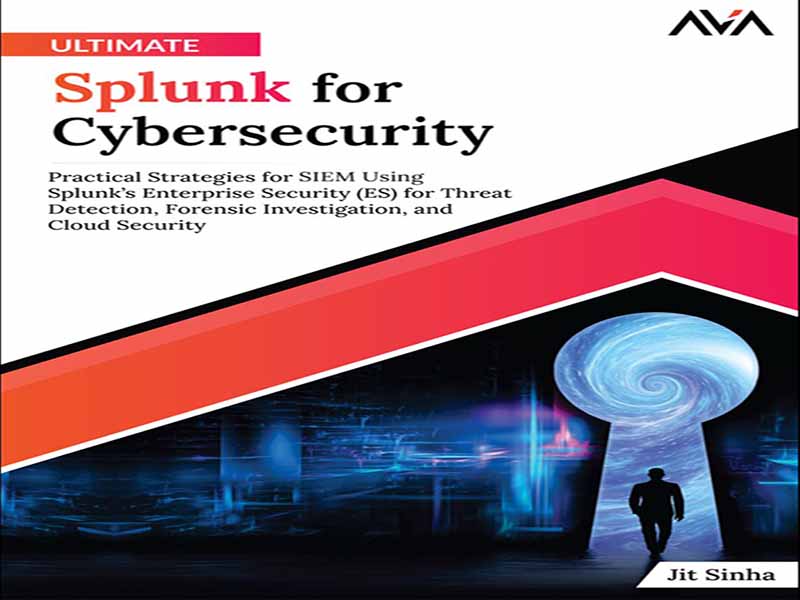- عنوان: Ultimate Splunk for Cybersecurity – Practical Strategies for SIEM Using Splunk’s Enterprise Security (ES) for Threat Detection
- نویسنده: Jit Sinha
- حوزه: شکار تهدید, تهدیدات سایبری
- سال انتشار: 2024
- تعداد صفحه: 463
- زبان اصلی: انگلیسی
- نوع فایل: pdf
- حجم فایل: 8.12 مگابایت
در دنیای به سرعت در حال تحول امنیت دیجیتال، کتاب «تسلط بر Splunk برای امنیت سایبری» به عنوان یک راهنمای جامع، شکاف بین دانش نظری و کاربردهای عملی Splunk در حوزه امنیت سایبری را پر میکند. فصل 1: مقدمهای بر Splunk و امنیت سایبری، زمینه را برای کاوش ما فراهم میکند و اهمیت Splunk را به عنوان ابزاری در چشمانداز امنیت سایبری و ارتباط آن در عصر دیجیتال کنونی تشریح میکند. فصل 2: مروری بر معماری Splunk به جنبههای ساختاری Splunk میپردازد و درک دقیقی از چارچوب و اجزای آن ارائه میدهد که برای درک پتانسیل کامل آن ضروری است. فصل 3: پیکربندی ورودیها و منابع داده بر مراحل اولیه لازم برای ادغام منابع داده مختلف در Splunk، یک فرآیند اساسی برای تجزیه و تحلیل مؤثر دادهها، تمرکز دارد. فصل 4: دریافت و نرمالسازی دادهها، تکنیکها و اهمیت پردازش و استانداردسازی دادهها در Splunk را برای اطمینان از دقت و ارتباط در تجزیه و تحلیل امنیتی مورد بحث قرار میدهد. فصل 5: درک SIEM، مفهوم مدیریت اطلاعات امنیتی و رویدادها را بررسی میکند و بر نقش حیاتی آن در استراتژیهای مدرن امنیت سایبری و چگونگی بهبود این سیستمها توسط Splunk تأکید دارد. فصل 6: امنیت سازمانی Splunk (ES) خوانندگان را با پلتفرم امنیتی اختصاصی Splunk آشنا میکند و قابلیتهای آن را در افزایش اقدامات امنیت سایبری سازمانی برجسته میسازد. فصل 7: هوش امنیتی، استفاده استراتژیک از Splunk را در جمعآوری و تحلیل اطلاعات امنیتی برای شناسایی و کاهش پیشگیرانه تهدیدات بالقوه پوشش میدهد. فصل 8: بررسی پزشکی قانونی حوزههای امنیتی، چگونگی استفاده از Splunk را برای تجزیه و تحلیل عمیق پزشکی قانونی، کمک به بررسی و درک حوادث امنیتی، بررسی میکند. فصل 9: ادغام Splunk با سایر ابزارهای امنیتی، بر اهمیت ادغام Splunk با انواع ابزارهای امنیتی دیگر، افزایش عملکرد و دامنه آن در اکوسیستمهای امنیت سایبری تأکید میکند. فصل 10: Splunk برای الزامات انطباق و نظارتی، در مورد چگونگی کمک Splunk به سازمانها در رعایت استانداردهای انطباق و مدیریت چالشهای نظارتی، که یک جنبه حیاتی در چشمانداز امنیتی فعلی است، بحث میکند. فصل 11: هماهنگی، اتوماسیون و پاسخ امنیتی (SOAR) با Splunk، نقش Splunk را در خودکارسازی و سادهسازی عملیات امنیتی، افزایش کارایی و اثربخشی استراتژیهای پاسخ، برجسته میکند. فصل ۱۲: امنیت ابری با Splunk به چالشهای منحصر به فرد ایمنسازی محیطهای مبتنی بر ابر و چگونگی استفاده مؤثر از Splunk در این سناریوها میپردازد. فصل ۱۳: DevOps و عملیات امنیتی، ادغام Splunk را در چارچوب DevOps بررسی میکند و تأثیر آن را بر همسوسازی عملیات امنیتی با فرآیندهای توسعه نرمافزار نشان میدهد. فصل ۱۴: بهترین شیوههای Splunk در امنیت سایبری، نکات و شیوههای تخصصی را برای به حداکثر رساندن اثربخشی و کارایی استفاده از Splunk در برنامههای امنیت سایبری به اشتراک میگذارد. فصل ۱۵: نتیجهگیری و خلاصه، کتاب را با خلاصه کردن بینشهای کلیدی و تأمل در نقش آینده Splunk در دنیای همواره در حال تغییر امنیت سایبری به پایان میرساند. این کتاب به عنوان یک راهنمای کامل برای هر کسی که به دنبال بهرهبرداری از قدرت Splunk در تلاشهای امنیت سایبری خود است، طراحی شده است، چه تازه سفر خود را آغاز کرده باشید و چه به دنبال تعمیق تخصص موجود خود باشید.
In the rapidly evolving world of digital security, “Mastering Splunk for Cybersecurity” serves as a comprehensive guide, bridging the gap between theoretical knowledge and the practical applications of Splunk in the field of cybersecurity. Chapter 1: Introduction to Splunk and Cybersecurity sets the stage for our exploration, outlining the importance of Splunk as a tool in the cybersecurity landscape and its relevance in the current digital era. Chapter 2: Overview of Splunk Architecture delves into the structural aspects of Splunk, providing a detailed understanding of its framework and components, essential for grasping its full potential. Chapter 3: Configuring Inputs and Data Sources focuses on the initial steps necessary for integrating various data sources into Splunk, a fundamental process for effective data analysis. Chapter 4: Data Ingestion and Normalization discusses the techniques and importance of processing and standardizing data within Splunk to ensure accuracy and relevance in security analysis. Chapter 5: Understanding SIEM explores the concept of Security Information and Event Management, emphasizing its critical role in modern cybersecurity strategies and how Splunk enhances these systems. Chapter 6: Splunk Enterprise Security (ES) introduces readers to Splunk’s dedicated security platform, highlighting its capabilities in enhancing organizational cybersecurity measures. Chapter 7: Security Intelligence covers the strategic use of Splunk in gathering and analyzing security intelligence to proactively identify and mitigate potential threats. Chapter 8: Forensic Investigation of Security Domains examines how Splunk can be utilized for in-depth forensic analysis, aiding in investigating and understanding security incidents. Chapter 9: Splunk Integration with Other Security Tools emphasizes the importance of integrating Splunk with a variety of other security tools, enhancing its functionality and scope in cybersecurity ecosystems. Chapter 10: Splunk for Compliance and Regulatory Requirements discusses how Splunk aids organizations in adhering to compliance standards and managing regulatory challenges, a critical aspect in the current security landscape. Chapter 11: Security Orchestration, Automation, and Response (SOAR) with Splunk highlights the role of Splunk in automating and streamlining security operations, enhancing the efficiency and effectiveness of response strategies. Chapter 12: Cloud Security with Splunk addresses the unique challenges of securing cloud-based environments and how Splunk can be effectively leveraged in these scenarios. Chapter 13: DevOps and Security Operations explores the integration of Splunk within the DevOps framework, demonstrating its impact on aligning security operations with software development processes. Chapter 14: Best Practices for Splunk in Cybersecurity shares expert tips and practices to maximize the effectiveness and efficiency of using Splunk in cybersecurity applications. Chapter 15: Conclusion and Summary concludes the book by summarizing the key insights and contemplating the future role of Splunk in the everchanging world of cybersecurity. This book is designed as a thorough guide for anyone looking to harness the power of Splunk in their cybersecurity endeavors, whether you are just beginning your journey or seeking to deepen your existing expertise.
این کتاب را میتوانید بصورت رایگان از لینک زیر دانلود نمایید.
Download: Ultimate Splunk for Cybersecurity




































نظرات کاربران